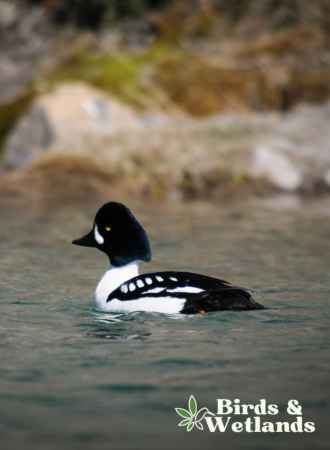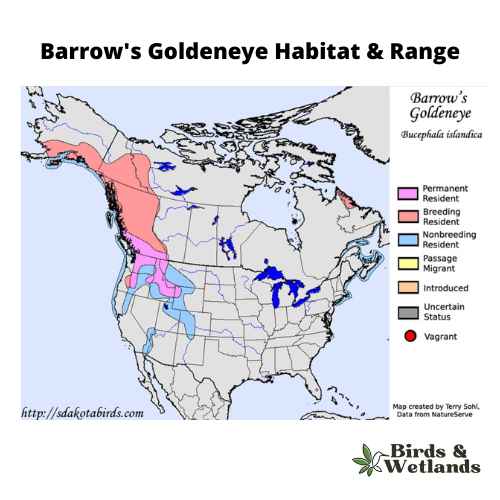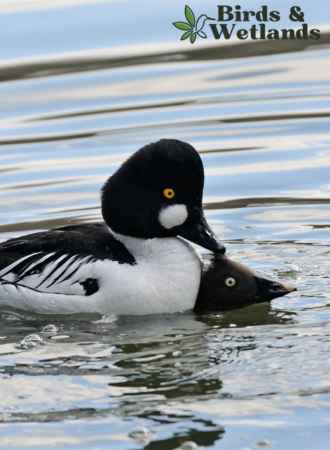
The Barrow’s Goldeneye is a medium-sized sea duck resident in northern North America and Iceland.
It belongs to the genus Bucephala, derived from an ancient Greek word meaning “ox’s head,” which refers to the shape of this sea duck’s head. Other ducks in this genus include the bufflehead and common goldeneye.
The species name “islandica” likely comes from the Latin term for Iceland, where these ducks are commonly found in the breeding season.
The Barrow’s Goldeneye got its common name due to its bright yellow eyes, which stand out against its dark head. This distinguishing feature was first noted by John Barrow when he encountered the species in Scotland during the 18th century, hence giving them their common name.
Scientific Name: Bucephala islandica
Length
- Male: 19.2 in (49 cm)
- Female: 17 in (43 cm)
Weight
- Male: 2.13 lb (970 g)
- Female: 1.31 lb (590 g)
Wingspan: 27.6-28.7 in (70-73 cm)
Physical Description

The adult male Barrow’s goldeneye has a snowy white underside and sleek black and white upper parts. Its head is dark and glossy, with a deep purple sheen, and its bright yellow eyes stand out against the dark feathers. Its tail is also dark and has a distinctive white crescent above its short, black bill.
The adult female Barrow’s goldeneye has a striking appearance, with a shiny dark chocolate-brown head and a bright yellow bill with a dark upper base. The mottled gray-brown back and wings contrast beautifully with the dark slate-gray tail, while the white collar adds a crisp touch to the overall look.
Listen to the Barrow’s Goldeneye
Range & Distribution

The Barrow’s goldeneye is a species of duck with a dispersed population throughout much of northern North America. Its range extends from Central Alaska and Oregon in the United States, staying west of the Rocky Mountains and includes parts of eastern Canada. A breeding population is also present in the Columbia Basin and Lake Lenore in Grant County, Washington.
In Iceland, the breeding populations of Barrow’s goldeneyes are mostly sedentary.
However, the western Alaskan population of Barrow’s goldeneyes migrates south to the Pacific coast and Puget Sound in the winter.
On the other hand, small flocks of Barrow’s goldeneyes that breed in eastern North America spend the winters along the northern Atlantic coast.
Habitat
The Barrow’s goldeneye prefers to breed in various shallow water habitats, including fresh water lakes, beaver ponds, and small sloughs. This bird is typically found in wooded areas, such as coniferous or aspen forests, and are known to nest in trees near the water.
When selecting breeding areas, Barrow’s goldeneyes look for lakes surrounded by trees, particularly black spruce, balsam fir, and white birch. These birds build their nests in the natural cavities of mature trees.
In addition to these physical requirements, the birds also need access to an ample food supply, such as small fish and insects, to sustain themselves and their offspring during the mating season.
In the winter, many Barrow’s goldeneyes form small flocks and congregate in sheltered coves or bays south of their breeding habitat, where they can feed on aquatic insects and mollusks without being disturbed.
Some Barrow’s goldeneyes may spend winters in protected coastal waters, freshwater lakes and ponds near rivers and streams. These areas provide access to abundant food sources and protection from more extreme winter weather conditions further inland. They are often seen with the other goldeneye species — the common goldeneye.
Feeding Habits & Diet
The Barrow’s goldeneye is a highly adaptable duck species with a varied diet that changes with the seasons and habitat.
During the breeding season, these ducks primarily feed on aquatic insects such as dragonflies, mayflies and backswimmer larvae. They supplement their summer diet with plant food such as rushes, sedges, pondweed and wild celery.
In the winter and non-breeding season, their diet consists mainly of aquatic invertebrates, crustaceans, mollusks, fish eggs and clams. They also feed on small fish like sculpins.
Barrow’s goldeneyes are prolific divers and opportunistic feeders. Their versatile feeding behavior allows them to find food sources even in challenging conditions.
As diving ducks, they diver underwater to forage food on the sea floor. They are also known to dislodge small rocks to search for small prey items.
In shallow water, Barrow’s goldeneyes use upending behavior, where they dip their head underwater to search for food along the bottom sediment with their bill or feet.
Nesting & Mating Habits

Barrow’s goldeneye ducks are believed to be monogamous. Pairs typically form in late winter or early spring at their wintering grounds. The breeding season starts mid-May to early June.
Shortly before the start of the mating season, males perform elaborate courtship displays to attract females. These displays involve head-pumping, wing-flapping, and vocalizations.
Barrow’s goldeneye ducks prefer to nest in cavities, such as those found in trees, cliffs, abandoned nests of other birds, abandoned buildings and large nest boxes. The females build the nests, typically made of grasses, mosses, and feathers, lined down from the female’s breast. These ducks often return to the same nesting site year after year.
The nesting sites of Barrow’s goldeneye ducks are typically found in coniferous or mixed forests near bodies of water, such as lakes or rivers. These ducks often nest near each other, forming small colonies.
The female lays 6 to 9 glossy greenish eggs, which she incubates alone for 27 to 30 days. The male leaves the female shortly before the start of the incubation period to join other males in molting areas located north of their breeding grounds.
Hours after hatching, the female leads the newly hatched ducklings out of the nest and into the nearby water. Young ducks can feed and search for food, but female Barrow’s goldeneyes will continue to look after them until they are fully fledged at about 8 to 9 weeks.
Threats & Conservation Status

The Barrow’s goldeneye is currently classified as “Least Concern” by the IUCN. Regardless, this diving duck faces challenges and threats to its existence, including human disturbance, climate change and predation.
Historically, this species was greatly affected by the Exxon Valdez oil spill, a horrible accident that happened in 1989 in Prince William Sound, Alaska. It took many years and conservation efforts for Barrow’s goldeneye population to reach its current population.
The U.S Fish and Wildlife Service shares information with local governments and landowners to protect the natural habitats of these birds for land use planning.
Hunting
Barrow’s goldeneye hunting is possible in a few places in the United States and Canada. These ducks are late winter migrants, so hunters across the continent should note when the birds travel south for winter.
Barrow’s goldeneyes nest mainly in Alaska, so their best chance to hunt them would be during their migration. They have been hunted with luck in parts of Montana, Washington, Wyoming, Colorado, and other areas with active waterfowl populations.
Key Points
- Barrow’s goldeneye ducks are North American birds that primarily eat aquatic insects, crustaceans and mollusks.
- These sea ducks often nest in tree cavities and rock crevices.
- The male has a crescent white patch on its dark head with purplish gloss.
- These ducks are closely related to the common goldeneyes. The two species are often found together in their wintering areas.

